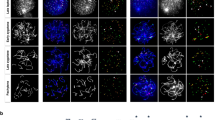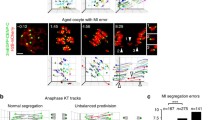Summary
We used an in vitro fertilization system to examine the effects of postovulatory oocyte age on nondisjunction at the second meiotic division. After ovulatory-inducing injections of hormone, we recovered mouse oocytes either at the estimated time of ovulation (controls) or 2, 4, 5, 10, or 14 h later. Oocytes were subjected to an in vitro fertilization procedure, and chromosomal preparations were made from first cleavage metaphase eggs. The first cleavage assay reveals morphologically distinguishable paternal and maternal chromosomes. Many of the aged oocytes were activated rather than fertilized by the in vitro procedure, but could still be analyzed for nondisjunction. We foun a tendency toward retention of the second polar body after 10 and 14 h aging. A total of 488 maternal genomes, 290 of which were in the control group, were analyzable for nondisjunction. Seven hyperhaploid genomes (2.4%) were observed in the controls and 6 (3.0%) in the combined aged group. The difference between these two frequencies is not significant (G adj=0.164,P>0.50). In the aged group, one hyperhaploid genome was in the 2-h population, three in the 5-h population, and two in the 10-h population. We were unable to find any significant increase in the frequency of nondisjunction after postovulatory oocyte aging.
Similar content being viewed by others
References
Austin, C. R. Chromosome deterioration in ageing eggs of the rabbit. Nature 213:1018–1019; 1967.
Buckland, R. A.; Evans, H. J.; Sumner, A. T. Identifying mouse chromosomes with the ASG technique. Exp. Cell Res. 69:231–236; 1971.
Donahue, R. P.; Karp, L. E. Chromosomal anomalies after fertilization of aged, postovulatory mouse eggs. Am. J. Hum. Genet. 25:24a; 1973.
Edwards, R. G.; Gates, A. H. Timing of the stages of the maturation divisions, ovulation, fertilization and the first cleavage of eggs of adult mice treated with gonadotrophins. J. Endocrinol. 18:292–304; 1959.
Fraser, L. R. Rate of fertilizationin vitro and subsequent nuclear development as a function of the post-ovulatory age of the mouse egg. J. Reprod. Fertil. 55:153–160; 1979.
German, J. Mongolism, delayed fertilization and human sexual behavior. Nature 217:516–518; 1968.
Hoppe, P. C.; Pitts, S. Fertilizationin vitro and development of mouse ova. Biol. Reprod. 8:420–426; 1973.
Juberg, R. C. Origin of chromosomal abnormalities: evidence for delayed fertilization in meiotic nondisjunction. Hum. Genet. 64:122–127; 1983.
Juberg, R. C.; Mowrey, P. N. Origin of nondisjunction in Trisomy 21 syndrome: all studies compiled, parental age analysis, and international comparisons. Am. J. Med. Genet. 16:111–116; 1983.
Kaufman, M. H. Parthenogenesis in the mouse. Nature 242:475–476; 1973.
Kaufman, M. H. Early mammalian development: Parthenogenetic studies. Cambridge: Cambridge University Press; 1983:9–16.
Kaufman, M. H. Early mammalian development: Partheogenetic studies. Cambridge: Cambridge University Press: 1983:197–223.
Kaufman, M. H.; Surani, M. A. H. The effect of osmolarity on mouse parthenogenesis. J. Embryol. Exp. Morphol. 31:513–526; 1974.
Marston, J. H.; Chang, M. C. The fertilizable life of ova and their morphology following delayed insemination in mature and immature mice. J. Exp. Zool. 155:237–252; 1964.
Martin-Deleon, P. A.; Boice, M. L. Spontaneous heteroploidy in one-cell mouse embryos. Cytognet. Cell Genet. 35:57–63; 1983.
Maudlin, I.; Fraser, L. R. The effect of PMSG dose on the incidence of chromosomal anomalies in mouse embryos fertilizedin vitro. J. Reprod. Fertil. 50:275–280; 1977.
McGaughey, R. W.; Chang, M. C. Chromosomes at prometaphase and metaphase of the first cleavage in mouse and hamster eggs. J. Exp. Zool. 177:31–40; 1971.
McGrath, J.; Hillman, N. Thein vitro transmission frequency of the t12 mutation in the mouse. J. Embryol. Exp. Morphol. 60:141–151; 1980.
Shaver, E. L.; Carr, D. H. Chromosome abnormalities in rabbit blastocysts following fertilization. J. Reprod. Fertil. 14:415–420; 1967.
Sokal, R. R.; Rohlf, F. J. Biometry. The principles and practice of statistics in biological research, 2nd ed. San Francisco: W. H. Freeman and Co.; 1981:731–747.
Szollosi, D. Morphological changes in mouse eggs due to aging in the fallopian tube. Am. J. Anat. 130:209–226; 1971.
Tarkowski, A. K. An air-drying method of chromosome preparations from mouse eggs. Cytogenetics 5:394–400; 1966.
Thibault, C. Normal and abnormal fertilization in mammals. Adv. Biosci. 6:63–85; 1971.
Vickers, A. D. Delayed fertilization and chromosomal anomalies in mouse embryos. J. Reprod. Fertil 20:69–76; 1969.
Yamamoto, M.; Ingalls, T. H. Delayed fertilization and chromosome anomalies in the hamster embryo. Science 176:518–521; 1972.
Author information
Authors and Affiliations
Additional information
This work was supported by National Institutes of Health, Bethesda, MD, grants HD-12035 and HD-19040 to PAM-D.
Rights and permissions
About this article
Cite this article
Zackowski, J.L., Martin-Deleon, P.A. Second meiotic nondisjunction is not increased in postovulatory aged murine oocytes fertilized in vitro. In Vitro Cell Dev Biol 24, 133–137 (1988). https://doi.org/10.1007/BF02623890
Received:
Accepted:
Issue Date:
DOI: https://doi.org/10.1007/BF02623890




